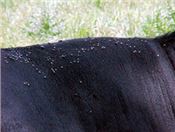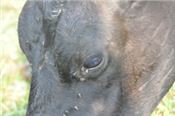|
Planning Checklist For Pasture Fly Control – 2016
DR. LEE TOWNSEND
LEXINGTON, KY.
Price breaks on early orders provide an incentive to make control decisions and purchases well before fly season begins. Here are a few things to consider as you weigh options and make decisions for pasture fly control for 2016.
Focus on the key pest in your herd. The one that is there every year; when its populations are high, there are significant losses in reduced production and extra expense in management time and effort.
Horn flies and face flies are key pests in Kentucky. Both breed in fresh cow manure. However, differences in their behavior present contrasting management challenges. Most fly control products are labeled for both insects, but there are differences in effectiveness of products and application options. Focus on the pest that most consistently causes problems.
Horn Fly
Horn flies (Figure 1) are blood feeders that take 20 to 30 small blood meals every day. Their constant biting causes stress and reduces weight gains in calves by as much as 12 to 20 pounds per head during fly season. In addition, horn flies can mechanically spread anaplasmosis and summer mastitis. Since horn flies are almost continuously on animals, they are exposed to insecticides applied by almost any treatment option – pour-ons, sprays, ear tags, etc. However, exposure to insecticides selects for horn flies that have some mechanism to cope with the insecticide; over time, this leads to resistant populations.
The face fly (Figure 2) uses its abrasive blotting mouthparts to irritate eyes as it feeds on tears and other secretions. In addition to this irritation, face flies can contribute to the spread of pinkeye. In contrast to the “stay-at-home” behavior of horn flies, face flies spend very little time on animals. They come occasionally for a few minutes, visiting the hard-to-treat face in order to feed on tears, saliva, and mucus.
Targeted insecticide applications tend to provide the best protection from face flies. Careful hanging of forced-use dust bags, attaching fly-flips to oilers, or using other supplemental treatment devices to target the head and face can give good face fly control, as well as managing horn flies. Adjusting nozzles on automatic sprayers will direct the liquid to the target most effectively. These self-application systems require some maintenance; check and refill them as needed.
If animals are moved regularly in a rotational grazing program, then fixed application stations may be less practical. Insecticidal ear tags provide a portable fly control system that moves with the animal. Tags tend to give very good horn fly control and a reduction in face fly numbers per head. Consider grazing practices and pasture layout. If cattle are in pastures with controlled access to water and mineral, then forced-use or self-treatment options (such as dust bags, back rubbers, or automatic spray devices) can be economical and effective. Spray or pour-on insecticides may be practical and very economical for horn fly control if there is a means of gathering up and confining/handling animals about once a month during fly season.
Past Performance
Were you satisfied with your 2015 fly control program? This can be can difficult to judge because of the extra rainfall over much of the state. Manure can stay moister longer, potentially increasing fly production and survival. Consequently, annual changes in fly numbers on cattle can be due as much to to weather conditions as product performance.
Resistance Management
It is important to consider your long term insecticide use patterns, particularly for horn fly control. Continued use of insecticides from the same mode of action group can lead to the development of pest populations that are more difficult to control. If you have been using pyrethroid ear tags for several consecutive years, incorporate insecticides with different modes of action into your program. Tags are available with insecticides that have one of several ways of attacking the pest, and there are some combination tags that pair insecticides with different modes of action.
Stay informed because options change as new products reach the market and older options disappear. Tolfenpro Insecticide Ear Tag is now available for horn fly and face fly control on beef and dairy cattle. Tolfenpyrad, the active ingredient, prevents insects from making the energy they need to live. On the other hand, this is the last year that insecticides containing endosulfan as an active ingredient (Avenger) can be used due to regulatory action.
There are many options for pasture fly control. Matching products and application methods best suited for your key pest and herd management practices will help you pick an effective strategy. ∆
DR. LEE TOWNSEND: Extension Entomologist, University of Kentucky

Figure 1. Horn flies.

Figure 2. Face flies.
Photos: Lee Townsend, UK
|
|